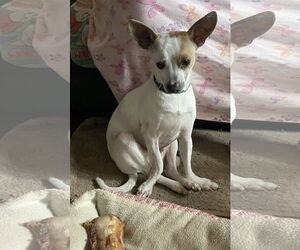
KEOLA - JACK RUSSELL TERRIER / RAT TERRIER (SHORT COAT) DOG FOR ADOPTION
Jack Russell Terrier Dogs For Adoption in Winter, WI, USA
For Adoption
-
Nickname:
Keola
-
Breed
-
Gender
Male
-
Age
Young
-
Location
Winter, WI, 54896 USAUSA
Description
Dog Breed: Jack Russell Terrier / Rat Terrier (short coat).
-
Physical Attributes
Coat Length: Short -
Behavioral Characteristics
OK with Kids: Yes OK with Dogs: Yes OK with Cats: Yes Other: - Crate Trained
- Good in a Car
- Likes to Play with Toys
-
Personality
Personality Characteristics - Obedient
- Timid
- Goofy
-
Additional Information
Was the Dog Found No
Let PuppyFinder Help!
Save Time. Get The Right Match. Buy Puppy Safer.
CREATE A WANTED ADRescue Information
-
Organization name
Saving Grace Animal Rescue
-
Location:
Winter, Wisconsin, 54896 USAUSA
Breed overview

Jack Russell Terrier
A.K.A.: JRT, Shorty Jack, English Jack Russell Terrier, Irish Jack Russell Terrier, Miniature Jack Russell Terrier, Hunt Terrier, Jack Russell, Working Terrier, Russell Terrier, Parson Russell Terrier
Overview:
The Jack Russell Terrier is a small, energetic dog breed originating from England in the mid-1800s, specifically bred by Reverend John Russell for fox hunting. These compact canines are easily recognized by their sturdy, muscular build, typically weighing between 13-17 pounds, with a height of 10-15 inches at the shoulder. Their coats can be smooth, broken, or rough, predominantly white with black, tan, or tricolor markings. Known for their spirited and confident temperament, Jack Russells are highly intelligent but can also be quite stubborn, requiring consistent training and ample mental stimulation. While devoted to their families, their high energy levels and strong prey drive make them better suited for active households with secure outdoor spaces rather than small apartments. They can thrive with children if properly socialized, though supervision is always advised due to their boisterous play. Generally healthy, they can be prone to certain genetic conditions such as patellar luxation, Legg-Calve-Perthes disease, and some eye disorders, making responsible breeding crucial.
See more...
